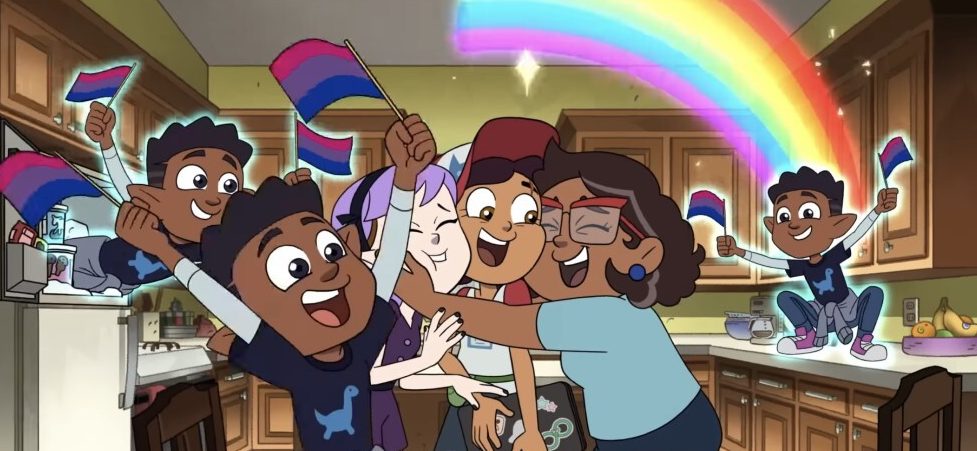by Anonymous

We always say that “representation matters”, but what constitutes good representation of minorities in the media?
Disney’s animated show “The Owl House” was released in 2020 and has received much praise for the diversity in its characters. However, it was announced (not long after its release) that the show will not continue past season 3, as the show “did not fit Disney’s brand”; no official statement was ever released regarding how exactly it deviates from the usual Disney series (Anderton, J, 2021). Though it is saddening to see it end so quickly, The Owl House was truly an amazing show.
There are definitely other examples of good representation, and it is far from perfect, but I chose The Owl House as I believe that representation in children’s media is especially important. Many studies have shown that as children learn by observing their surroundings, they are impressionable and very easily influenced by the media that they consume (“Adolescents and the Media: Medical and Psychological Impact,” 1995). Positive representation of different minority groups in children’s media encourages the younger generation to learn more about different communities, subverting existing stereotypes against certain minority groups.
Therefore, to celebrate the release of the first episode of the last season a few months back, let’s take a look into why I personally believe The Owl House to be a great example of what representation in media should look like.
One of my favourite things about the representation in this show is that they are not simply putting in characters as “token minorities”. More often than not, shows nowadays tend to include minorities as side characters to appear “progressive”; some creators expect praise and credits for doing the bare minimum of having characters of diverse backgrounds. Most of the main characters in The Owl House are canonically queer, which is actually much more common in real life compared to having one “gay best friend” in a heterosexual friend group, so common that many queer people have reported that they tend to “flock together” (Jernigan, C., & Mistree, B. F., 2009). As a result, queer people in the show have different personalities, ethnicities, interests, and style, subverting the stereotypes around the community and emphasising intersectionality.
It is also important to bring up the fact that the show educates young children about different sexualities and genders. Lilith Clawthorne is canonically aromantic and asexual, and Raine Whispers is non binary. These are parts of LGBTQ+ community that is often neglected when it comes to representation in media.
In addition, the show does not focus on how the characters face judgements for being queer, unlike most western media nowadays where nine out of ten times gay characters’ character arc revolves around the fact that they are queer. While the show addresses the struggles the main character, Luz, faces for being “different” or “weird”, she was never judged for being bisexual; a scene that I remember distinctly was that the “mean girl” or bully in the show, Boscha, had always mocked Luz for everything that she does, but never the fact that she is dating another girl, Amity, to which her only comment was “they are not that cute.” (Fun fact: Boscha has two moms.) Another scene I found worthy of note was when Amity’s mother, Odalia, said Luz was unfit for her daughter, and that she would find Amity “a new girlfriend”; even though Odalia is an overall insufferable person and had a questionable parenting style, she did not hold judgement for the fact that Amity is a lesbian. In most western media, typically teen dramas, the above examples would have been a perfect moment to introduce homophobia into the show, per usual; however, The Owl House chose not to and created a world of comfort for its audience. While characters still face many problems in their lives (spoiler alert: the world ending, and all that), being queer seems to be the norm, or at least as common as being cisgender and/or heterosexual in this world.
I believe that the kind of representation in The Owl House, where diversity is celebrated, is much more effective (compared to constantly emphasising on the negativity that queer people face) in educating the younger generation and allowing queer youth feel seen. Not only was diversity in sexuality shown in a sense that there are gay characters, but it was also shown within the community, educating its audience about the “Q+”. All in all, The Owl House did a great job in being truly inclusive of different sexualities and genders, and I can not wait to watch season 3 next year.
Works Cited
1. Adolescents and the media: medical and psychological impact. (1995). Choice Reviews Online, 33(02), 33–0735a. https://doi.org/10.5860/choice.33-0735a
2. Anderton, J. (2021, October 9). Owl House boss shares real reason why Disney cancelled the show. Digital Spy. Retrieved December 3, 2022, from https://www.digitalspy.com/tv/ustv/a37915254/owl-house-disney-cancellation-reason/
3. Disney Channel’s ‘The Owl House’ Gets Season 2 Order Ahead of Series Premiere (Exclusive). (2019, November 21). Hollywood Reporter. Retrieved December 4, 2022, from https://www.hollywoodreporter.com/tv/tv-news/disney-channels-owl-house-gets-early-season-2-order-1256811/
4. Jernigan, C., & Mistree, B. F. (2009). Gaydar: Facebook friendships expose sexual orientation. First Monday. https://doi.org/10.5210/fm.v14i10.2611
5. Terrance, D. (Director). (2020, January 10). The Owl House. Disney.
